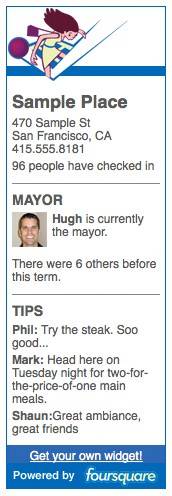
Geolocation social networks are set to be in 2010 what microblogging was in 2008 – the next big thing. Currently the space is being dominated by
, with others like
,
and
trailing in its wake.
While Gowalla has secured a large amount of funding, some $8.5 million, and My Town claims more check-ins than the other services, Foursquare is happily ticking along on the seed money provided by its founders (after they sold their original effort, Dodgeball, to Google), and creating a community of developers who are eager to build secondary applications. There are two reasons Foursquare is gaining so much ground over its competitors.
This is a guest post by Simon Salt, the founder and CEO of IncSlingers. He is a writer and blogger whose work has appeared in a wide variety of places, including Chris Brogan’s Dad-O-Matic.com, American Marketing Association News and the Austin Realtor. He has been quoted in the Wall Street Journal on social media and is a recognized national speaker on that topic as well.
Firstly, it is available on all phone platforms. While this is also true of Loopt, the game play element of Foursquare makes it more attractive to many users. Secondly, it took the very sensible step of opening its API early on. This has generated a wave of new secondary applications.

In addition to this, it set up a developer community forum and is extremely active there, providing support, information and assistance to developers that are creating these secondary apps. Just as with Twitter, it is not just the service itself that will create demand, but the applications that run from that service.
There are hundreds of applications that run on the Twitter API now (most of which are listed at oneforty.com). It is very likely that by the end of 2010 we will see similar numbers of applications for Foursquare, and, should Gowalla and the rest open their APIs, for those services too.
The reason geolocation social networking is so popular is quite simply its ease of use. Arrive at a destination, be that your work, the gym, a coffee shop or even the grocery store, fire up the application on your phone, “check-in”, and get points, badges and even increased status in the game for doing so.
As with Twitter, early adopters are the ones using the sites the most at the moment, but the services are rapidly spreading beyond the hard core. Unlike micro-blogging, you need no talent to be entertaining, informative or stylish – you simply check-in as you go about your day. You attract “friends” by doing this, or by connecting with people you already know, either online or in real life.
The Next Step: User- and Location-Focused
As with so many other early-stage social network platforms, extending the service with secondary applications is what makes the service truly useful.
At present, the secondary applications that are being developed fall into two main categories: user-focused and location-focused. A good example of a user-focused app is wheredoyougo. This service provides a heat map visual of all of a user’s check-ins. Another, foursqpic allows users to upload pictures as part of the Foursquare Venue Tips section, supplementing simple text tips with visuals as well. These are great apps and certainly add to the fun and extend the functionality of the service. However, the real gains are coming in the location-focused apps.
So far, the most developed of these is placewidget, which allows owners of a location to promote, via a website widget, the “Mayor” of their location on their website. Until now, any real marketing revolving around Foursquare was offline, and had to be location-specific. By bringing the ability to market both their involvement in the Foursquare community and promote a loyal customer, this widget gives a lot more power to businesses looking to leverage this type of social networking.

Foursquare recently announced it had signed two deals with media outlets. The first is an agreement with Metro, Canada’s number one free daily newspaper, to have content for venues provided by the newspaper. The second is with Bravo TV, which will include Bravo Celebrity Tips and Bravo-branded badges for over 500 locations. A game is great, but a content-rich social network is something a lot more valuable.
Photo credit: Agata Urbaniak




















